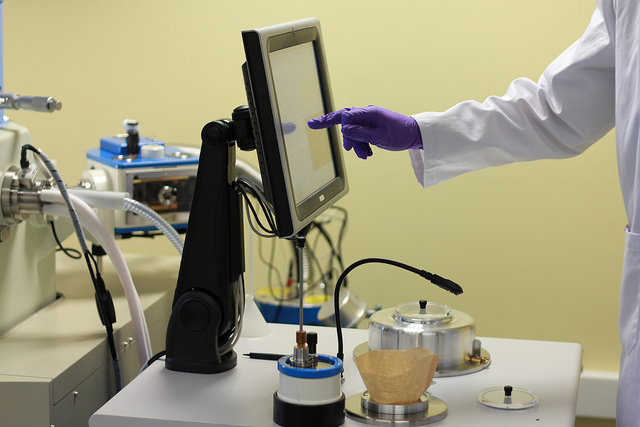The dramatic cuts in capital funding in 2011 rocked academics working in scientific research. However as Lancaster University VC Mark Smith reports, this shock to the system has enabled the concept of equipment sharing to gain real ground.
Autumn statements have become another of those political events in the calendar those sectors that have some dependence on public funding cast a nervous eye towards.
Following the 2010 election, the Autumn statement of that year – Chancellor Osborne’s first – contained a whole string of reductions as the government started to get to grips with the fiscal deficit.
As a then deputy vice chancellor, but also an active experimental physicist, there was a sigh of relief that the science ringfence held, only having to absorb the erosion in value of the flat-cash settlement. However the sting in the tail was the projected eye-watering reductions in the capital, so crucial to keep UK research genuinely competitive, on top of the Wakeham review on efficiencies of the research base.
Over the spending review period, reductions in science capital of between 35% and 45% were projected depending, as often in politics, how you do the calculation. Very real examples were the 66.5% cut in HEFCE’s science capital budget between 2010-11 and 2011-12. The research councils also had to react rapidly to this very significant loss of resources and chose a number of ways.
Radical change
The funding realities projected at that time meant that simply continuing to use the same approach to funding equipment, but doing much less of it, was not an adequate response. It needed a radical change of approach and philosophy. The new process from EPSRC was that equipment – initially above £50,000, but now £111,676 – could not be directly included on grants and had to go via a separate strategic equipment panel. As an equipment heavy researcher, my immediate personal response to these changes and the reduction in funding, was to ask myself “is this the beginning of the end?”.
However four years on what has happened? First, capital money flowed back into the system as the Chancellor has recognised the underpinning importance of such capital to long term economic growth and in difficult times his support of the research base is welcome. The evolution of this into the new capital roadmap published last December, although a little short of detail in places, has moved the UK on both in terms of vision and planning as well as the commitment of resources.
The concept of equipment sharing has gained real ground. Research universities reacted by rapidly compiling equipment databases and through the developing regional groupings in England such N8, M5, GW4 and SES5 started to parallel the ‘pooling’ activity in Scotland. The development of regional databases readily shareable across these groups of universities opened the way for the discussion about real sharing.
The extension into the progenitor of a national database in the Loughborough-led Kit Catalogue project is the further evolution of this concept. A welcome additional benefit from accessibility of this information is the much improved potential for interaction with business.
Changing attitudes
Being able to access data to understand what could be shared is one thing, changing attitudes and behaviours is quite another. With necessity being one of the mothers of invention, two factors converged to accelerate thinking in this area.
The key catalyst was undoubtedly the 2011 capital squeeze, with a secondary, and not to be underestimated driver being that for certain key experimental techniques (such as Neuro Magnetic Resonance and electron microscopy) the cost of leading-edge instrumentation is now well beyond the level of resource that should be allocated to a single research group or even institution. These pressures meant that there was a willingness on the part of university administrators and academic researchers to rethink their attitudes towards collaboration across departments and faculties, and by extension between groups of universities. Hence many more bids have become multi-investigator and multi-institutional.
EPSRC commissioned the N8 to report on the opportunities, barriers and best practice in equipment sharing. Seven organisational success factors were identified, but having clear national strategies around particular techniques, allowing scientists and users to design the approaches and systems for sharing and, perhaps most important of all, building the trust so individuals and organisations were more comfortable with the concept of collaborating to compete, have all been crucial.
So what has happened to EPSRC’s strategic equipment panel? In some ways it has been transformational to thinking in this area, requiring prior consideration about the possibility of asset sharing, managing access for a broader base of users and business cases as to the medium term sustainability, but nevertheless secondary to the scientific quality of the work to be carried out.
I strongly believe this process has improved the sophistication of thinking about the capital assets the research base needs, how progress to genuine sustainability might be achieved, and, yes, a much more efficient use of the equipment purchased under this scheme than would otherwise have been achieved. A full systematic study in the next few years to prove this point would be great.
Sustainability
Although the most recent capital roadmap indicates quite healthy levels of capital funding, if the profile sticks, the progress in asset sharing should not be lost and, if at all possible, be advanced. As Professor Sir Ian Diamond is about to report on possible further efficiencies in higher education the advances made with regards to equipment sharing and sustainability since 2010 should be noted as a real contribution to efficiency in the HE sector.
One of the components of his review will look at where more progress can be made in improving the efficient use of the research base and strengthening of collaborative networks. To take things even further, incentives such as ensuring credit is distributed amongst partners on large collaborative equipment items are crucial and more flexibility between capital and operational costs would be helpful.
All international studies show the UK research system is not only one of best in terms of quality, it is also one of the most efficient. A US visitor recently remarked to me, “the UK is a very interesting research ecosystem which has a combination of scale, both of researchers and investment, physical proximity and sophistication of thinking about sharing that probably take it well beyond any other in the world”. Now that is one to think on.
Professor Mark E. Smith is the Vice-Chancellor of Lancaster University
photo credit: foto_mania via photopincc








